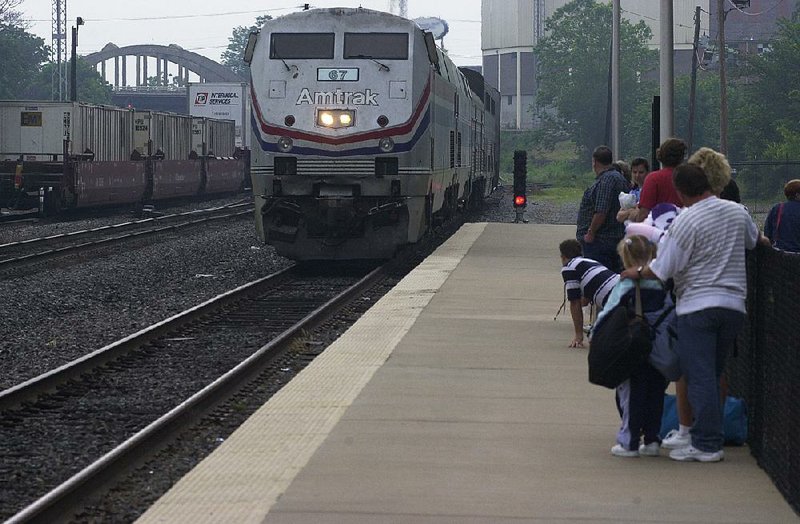Ridership on the Texas Eagle, a long-distance Amtrak route that makes six stops in Arkansas, has increased by 65 percent in recent years, but Little Rock station usage has remained stagnant since 2010.
Almost 22,000 passengers used the Little Rock stop at Union Station in 2013, down slightly from 23,557 in 2012, but on par with usage in 2010 and 2011.
The Texas Eagle averaged almost 26,000 riders per month in the first eight months of fiscal year 2014. Amtrak expects 340,851 riders on the route this year. Ridership has increased every year since 2007.
Bill Pollard, a Conway dentist who also serves as the chairman of the Texas Eagle Marketing and Performance Organization, said the Texas Eagle, connecting Chicago and San Antonio, regularly sells out during peak travel periods in the summer and around the holidays. Cash-strapped Amtrak can't afford to add passenger cars during busy seasons, meaning Texas Eagle seats often sell out.
"We're in kind of a catch-22 situation," Pollard said. "When there's great demand, we don't have the capacity and when there's not great demand, we can't keep up with on-time performance."
Amtrak spokesman Marc Magliari said Amtrak is focused on upgrading baggage cars that date to the Truman and Eisenhower administrations before adding new passenger cars. Amtrak also provides small, package-freight delivery service.
Of the Texas Eagle's 340,081 riders in fiscal 2013, 41,183 boarded or exited the train in an Arkansas city. The train makes daily trips from Chicago to San Antonio and continues to Los Angeles three times per week as the Texas Eagle/Sunset Limited train.
For every dollar in revenue the Texas Eagle generates, Amtrak will spend more than $2, according to fiscal 2014 budget projections. Budget projections through 2018 indicate Amtrak expects Texas Eagle ridership to grow, but it expects the 2-to-1 expense-revenue ratio to hold steady. None of Amtrak's other long-distance lines are profitable, nor are they expected to become profitable.
Magliari said the long-distance trains are still considered an essential part of Amtrak's public service. Ticket fares cover about 80 percent of Amtrak's operating costs. Amtrak works to keep travel times faster than automobile trips and aims to appeal to drivers, not fliers. Some riders are attracted to Texas Eagle's more direct route south.
"It's clear that people are looking for a better option [than driving]," Magliari said.
The Texas Eagle also makes stops in Arkadelphia, Malvern, Texarkana, Walnut Ridge and Hope. The Hope station opened in April 2013.
Nearly all of the Arkansas stops are in the middle of the night. The train is scheduled to pass through Arkansas between 12:37 and 5:58 a.m. on the southbound Chicago-San Antonio route and between 8:43 p.m. and 1:41 a.m. on the San Antonio-Chicago route.
In 2013, the Arkansas congressional delegation sent a letter to Amtrak's president asking him to consider altering the Texas Eagle schedule to avoid the middle-of-the-night stops. Pollard said Amtrak is considering the request. Altering train times would require negotiations with the freight companies, such as Union Pacific, that own the tracks and the Amtrak hub in Chicago.
"The whole process just moves at a glacial speed," Pollard said. "But I was so pleased Amtrak and the Texas Eagle was something we could all come together on."
Pollard said that while the Little Rock station is not heavily trafficked, it's important for the station to stay in operation as Amtrak considers adding more lines to the region. He said Amtrak is conducting feasibility studies for service between Memphis and Texarkana.
"One train a day in the middle of the night is not what anyone sees as the absolute answer for transportation," Pollard said. "What it's also doing is basically preserving the franchise. Once it's gone, it's almost impossible to get back."
The Hope station is one case where Amtrak revived a shuttered platform. Between April 2013 and September 2013, the Hope station saw 1,310 passengers. Hope-Hempstead County Chamber of Commerce director Mark Keith said he's surprised by how much the new station has been used. He usually sees people waiting for the train for both its 5:09 a.m. southbound stop and 9:18 p.m. return trip.
"I guess everything old is new again," Keith said. "You see a lot of activity there. It's pretty significant for a small town that hasn't had train service in 45 years."
Business on 08/05/2014
